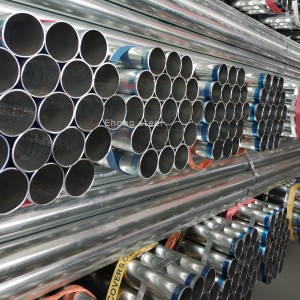Difference between pre-galvanized pipe and Hot-DIP Galvanized Steel Pipe

1. Difference in process:Hot-dip galvanized pipe is galvanized by immersing the steel pipe in molten zinc, whereas pre-galvanized pipe is evenly coated with zinc on the surface of the steel strip by an electroplating process.
2. Structural differences:Hot-dip galvanized pipe is a tubular product, while pre-galvanized steel pipe is a strip product with a larger width and smaller thickness.
3. Different applications:Hot galvanized pipes are mainly used for transporting liquids and gases, such as water supply pipes, oil pipelines, etc., while pre-galvanized steel pipes are mainly used for manufacturing various metal products, such as automotive parts, home appliance shells and so on.
4. Different anti-corrosion performance: hot-dip galvanized pipe has better anti-corrosion performance due to thicker galvanized layer, while galvanized steel strip has relatively poor anti-corrosion performance due to thinner galvanized layer.
5. Different costs: the production process of hot-dip galvanized pipe is relatively complex and costly, while the production process of galvanized steel pipe is relatively simple and low cost.
Inspection of pre-galvanized and hot-dip galvanized steel pipe quality
1. Appearance inspection
Surface finish: Appearance inspection is mainly concerned with whether the surface of the steel pipe is flat and smooth, without obvious zinc slag, zinc tumor, flow hanging or other surface defects. Good galvanized steel pipe surface should be smooth, no bubbles, no cracks, no zinc tumors or zinc flow hanging and other defects.
Color and uniformity: Check whether the color of the steel pipe is uniform and consistent, and whether there is uneven distribution of the zinc layer, especially in the seams or welded areas. Hot-dip galvanized steel pipe generally appears silvery white or off-white, while pre-galvanized steel pipe may be slightly lighter in color.
2. Zinc thickness measurement
Thickness Gauge: The thickness of the zinc layer is measured using a coated thickness gauge (e.g. magnetic or eddy current). This is a key indicator to determine if the zinc coating meets the standard requirements. Hot-dip galvanized steel pipe usually has a thicker zinc layer, typically between 60-120 microns, and pre-galvanized steel pipe has a thinner zinc layer, typically between 15-30 microns.
Weight method (sampling): Samples are weighed according to the standard and the weight of the zinc layer per unit area is calculated to determine the thickness of the zinc layer. This is usually determined by measuring the weight of the pipe after pickling.
Standard requirements: For example, GB/T 13912, ASTM A123 and other standards have clear requirements for the thickness of the zinc layer, and the zinc layer thickness requirements for steel pipes for different applications may vary.
3. Uniformity of galvanized layer
High quality galvanized layer is uniform in texture, no leakage and no post plating damage.
No red ooze is found after testing with copper sulfate solution, indicating no leakage or post-plating damage.
This is the standard for high quality galvanized fittings to ensure optimum performance and appearance.
4. Strong adhesion of galvanized layer
The adhesion of the galvanized layer is an important indicator of the quality of galvanized steel pipe, which reflects the degree of solidity of the combination between the galvanized layer and the steel pipe.
The steel pipe will form a mixed layer of zinc and iron with the galvanizing solution after the reaction of dipping bath, and the adhesion of the zinc layer can be enhanced by the scientific and precise galvanizing process.
If the zinc layer does not come off easily when tapped with a rubber mallet, it indicates good adhesion.
Post time: Oct-06-2024







